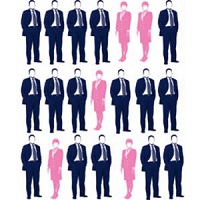Representation of women in BiH’s political life
 By: Edita Miftari
By: Edita Miftari
In political life of Bosnia and Herzegovina there is no equality between men and women. There is small number of women that are political leaders on state level, but also on local levels. We could take for example results of previous local and general elections in order to prove that fact. Despite the democratization that took place in Bosnia and Herzegovina after war, from 2002nd to 2012th we could notice stagnation in increase of participation of women in political life. Despite the fact that women have never made less than 50% of the electorate, there was rarely more than 50% of women voters on elections so far. The biggest number of women voters was registered on elections in 2006.
Bosnia and Herzegovina can be compared with countries like Saudi Arabia and Cambodia in number of women that are members of ministry or parliament. Current members of Council of ministers are only men. There is nine women out of 42 members in House of Representatives of parliamentary Assembly, and there are two women out of 15 members in House of people. There is only one woman out of 17 positions in ministry of Federation. In the House of Representatives of the Federal Parliament there are 22 women out of 98 representatives (22.4%), and in House of people there are 14 women (24.1%) out of 58 positions. Naming of five women (31%) in Government of Republic of Serbian is positive example. Another positive example is naming the first woman for Prime Minister in Republic of Serbian in 2013. In National Assembly of Republic of Serbian there is 18 women out of 83 positions (21.7%).
From 2002nd to 2012th it wasn’t registered a significant increase of women candidates on general and local elections. The quota was between 35% and 36.82%. Election of women candidates in general and local elections was in constant decline from 2002nd to 2008th . From 2004th to 2012 th for chief position there was low share of women candidates (from 3.69% to 6.36%).. The biggest share of elected women chiefs was on local elections in 2012. There was five women on chief positions out of 143 townships.
After the harmonization of the Election law with the Law of Gender Equality that happen in 2013., there must be minimum 40% of less represented gender on selection lists. These changes were implemented for the first time on previous general elections that happened on 12. October 2014. Out of 7748 candidates there was 3276 women candidates (42%). Amendments to the Election law imposed this increase, and 42% of women on selection lists is legal minimum. Bosnia and Herzegovina use open lists system, so there is no guarantee that number of elected women will increase after General elections 2014. In following period we can only wait for results in order to check efficiency of correlation of gender quotas and open lists.
Source of statistical data:
The Central Election Commission (2012.), Optional indicator 2002-2012, Sarajevo
Available on: http://www.izbori.ba/Documents/Statistika_i_rezultati_izbora/Statistika_izbora/Izborni_pokazatelji2002-2012.pdf